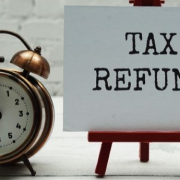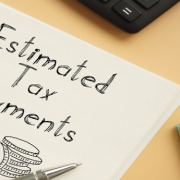What Are The Tax Rates For Different Types Of Retirement Income?
Navigating income taxes during retirement can be complex and your golden years are a time to relax and enjoy your hard-earned cash.
Your IRAs, pensions, taxable accounts and Social Security distributions create various tax implications. So, it’s vital to understand them and implement strategies to reduce your tax liability and maximize your retirement funds. You may want to speak with a financial advisor to get a more personal look at how your income will be taxed in retirement.
Federal Tax Rates For Different Types Of Retirement Income
Federal tax rates vary by income type and level. It’s important to evaluate what each type of income you expect is going to look like so that you can plan for retirement. Here’s a breakdown of the most common taxes during retirement:
IRAs And 401(k)s
Traditional IRAs and 401(k)s offer tax-deferred growth, meaning you don’t pay taxes on the contributions or investment earnings until you withdraw the funds in retirement. Withdrawals from these accounts are generally taxable income. The tax rate depends on your total income, filing status and the federal income tax brackets in effect during the year of withdrawal.
On the other hand, you fund Roth IRAs and Roth 401(k)s with after-tax contributions, meaning you pay taxes on the money before it goes into the account. Qualified withdrawals from Roth accounts, including both contributions and earnings, are tax free.
Taxable Accounts
Taxable accounts, such as brokerage and savings accounts, use after-tax money. Therefore, you’ll pay taxes on any interest, dividends or capital gains earned from investments in these accounts. Specifically, interest income incurs regular income tax rates, while dividends and capital gains receive different rates depending on how long you hold the investments before selling (short-term vs. long-term).
Selling assets after holding them for less than a year creates short-term capital gains taxes, which the government treats as regular income. On the other hand, selling assets after holding them for a year or more creates long-term capital gains taxes, as seen below:
Pension Income
Monthly payments from your employer’s pension program or a private annuity will incur standard income taxes. In addition, if you opt for a one-time lump sum payment that empties your pension, you’ll owe income taxes for the entire amount.
Remember, employer pension payments come to you after having a specific amount of taxes subtracted. This feature means a large tax bill won’t wallop you when you file (provided you haven’t had an unexpected infusion of income from elsewhere that year).
Earned Income
Earned income receives standard tax rates, like many other types of income listed. However, wages from an employer or self-employment are subject to Social Security and Medicare taxes, also known as FICA. FICA taxes incur an additional 7.65% rate on income from a part-time job and 15.3% from self-employment income (you’ll receive half of that back when you file taxes).
Remember, earned income can run up against Social Security benefits if you make too much. Specifically, for 2023, earning more than $21,240 results in a $1 reduction for every $2 earned after the threshold if you’re under what the government considers full retirement age. Once you reach full retirement age, the limit changes to $56,520 and the penalty is a $1 reduction in benefits for every $3 earned.
Social Security
Social Security also receives taxation based on your income level and filing status. The Social Security Administration adds your adjusted gross income with nontaxable interest income and half of your Social Security benefits when calculating income thresholds for taxes. Then, the government charges federal income tax rates on 50% or 85% of your Social Security check.
The chart below outlines the different possible circumstances and tax rates:
Single Filers Income Percentage of Social Security Income Taxed $0 – $24,999 0% $25,000 – $34,000 50% $34,001+ 85% Married Filing Jointly Income Percentage of Social Security Income Taxed $0 – $31,999 0% $32,000 – $44,000 50% $44,001+ 85%
Keep in mind, if you are married and choose to file a separate tax return, it is likely that you will be required to pay taxes on your benefits.
How To Minimize Your Tax Liability In Retirement
Most people have the very similar goal of trying to reduce the potential tax liability during retirement. While the income you bring in and where you live are going to play a huge role in the taxes you pay, there are some things you can do to improve your situation. In fact, the tips below can help reduce your tax burden during retirement.
1. Remember To Withdraw Your Money From Your Retirement Accounts
Once you reach the age of 73 (or 70½ if you were born before July 1, 1949), you must begin taking required minimum distributions (RMDs) from most retirement accounts, such as traditional IRAs and 401(k)s. Failing to withdraw the RMD amount results in a 25% penalty on the neglected sum plus the income tax it would have incurred.
However, if you have multiple retirement accounts, you have some flexibility in choosing which account(s) to withdraw from. By strategically planning your withdrawals, you can control the timing and amount of taxable income and optimize your tax situation.
2. Understand Your Tax Bracket
Understanding your tax bracket is crucial for retirement planning. You can minimize your tax liability by managing your taxable income to stay within a lower tax bracket. So, it’s best to use the tables above and the federal income tax brackets for the year to calculate a comfortable amount of income without exposing your money to higher rates.
3. Make Withdrawals Before You Need To
You can plan your withdrawals strategically if you have a mix of taxable and tax-advantaged accounts, such as a 401(k) and a Roth IRA. Making withdrawals from taxable accounts or tax-free accounts like Roth IRAs before you need the funds can help reduce your future RMDs and potentially lower your overall tax burden in retirement.
4. Invest In Tax-Free Bonds
Tax-free bonds, such as municipal bonds, can be an attractive investment option for retirees seeking tax efficiency. Interest income from municipal bonds is usually exempt from federal income tax and sometimes from state and local taxes.
5. Invest For The Long-Term, Not the Short-Term
Holding investments for the long term, particularly in taxable accounts, can be advantageous from a tax perspective. Specifically, when you sell investments held for more than one year, you qualify for long-term capital gains tax rates, which are typically lower than ordinary income tax rates. By avoiding frequent buying and selling, you can minimize the realization of short-term capital gains, which receive the standard federal income tax rates.
For example, say you’re a single filer with a $44,000 income. Part of that income is from capital gains. However, if the capital gains are short-term, your marginal tax bracket is 12%, while your long-term capital gains bracket is 0%.
6. Move To A Tax-Friendly State
Some states have lower or no state income taxes, which can significantly impact your overall tax burden in retirement. If feasible, consider relocating to a tax-friendly state. However, before making such a decision, it’s essential to assess various factors like cost of living, healthcare and personal preferences. Remember, the states that don’t charge personal income taxes are Alaska, Florida, Nevada, New Hampshire, South Dakota, Tennessee, Texas, Washington and Wyoming.
The Bottom Line
The type of income that you receive in retirement could change the way that it is taxed. Many can avoid some of this by moving to a tax-friendly state, but most people can’t avoid it entirely. It’s important to understand what your personal tax liability could potentially become and to plan accordingly so that you’re prepared for retirement when it comes.
Source: yahoo!finance






